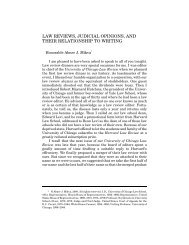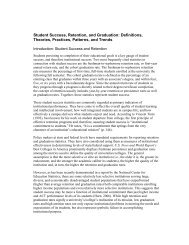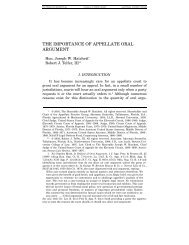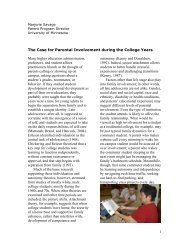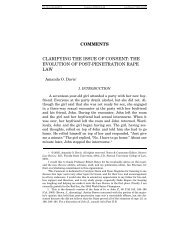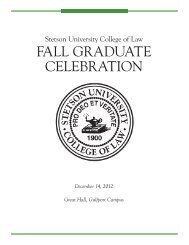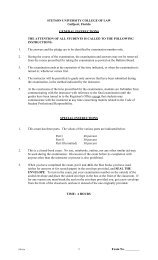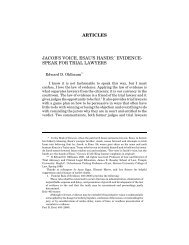The Future of Single-Sex Education After United ... - Stetson University
The Future of Single-Sex Education After United ... - Stetson University
The Future of Single-Sex Education After United ... - Stetson University
Create successful ePaper yourself
Turn your PDF publications into a flip-book with our unique Google optimized e-Paper software.
FILE:C:\WP51\DOCS\LANDFeb 02/21/2 Thu 3:26PM1997] <strong>Single</strong>-<strong>Sex</strong> <strong>Education</strong> 315have found that these benefits exist at all levels <strong>of</strong> women's educationaldevelopment, from primary school to college education. 126Also documented, although not as comprehensively, is a benefitto males in single-sex educational settings. One study has shownthat both boys and girls in single-sex schools outperform theircoeducated counterparts, 127 and that men's colleges are more likelyto produce males with career plans in traditionally respected fields,such as law and business. 128<strong>The</strong>se benefits found in single-sex educational settings aretraceable to the different techniques for delivering information ingirls' and boys' schools. 129 <strong>The</strong> different techniques used in maleand female schools are formulated on the basis <strong>of</strong> real gender differencesbetween male and female physical and educational development.130VA. L. REV. 295, 324–25 (1984) and Deborah L. Rhode, Association and Assimilation, 81NW. U. L. REV. 106, 141 (1986)). For further discussion <strong>of</strong> the positive effects <strong>of</strong> attendanceat women's colleges, see Daryl G. Smith, Women's Colleges and Coed Colleges: Is<strong>The</strong>re a Difference for Women?, in WOMEN IN HIGHER EDUCATION: A FEMINIST PERSPEC-TIVE 311, 318 (Judith S. Glazer et al. eds., 1993) (stating that “women's colleges relatepositively to a variety <strong>of</strong> measures <strong>of</strong> student satisfaction, perceived changes in skillsand abilities, and educational aspirations and educational attainment”); Beth Willinger,<strong>Single</strong> Gender <strong>Education</strong> and the Constitution, 40 LOY. L. REV. 253, 255–56 (1994) (delineatingmany positive effects for women who attend women's colleges, including positiveself-image and self-esteem, full participation in college activities, higher rate <strong>of</strong> completion<strong>of</strong> advanced degrees, higher representation <strong>of</strong> graduates in the work-force, and overrepresentationin high-level political positions).126. Compare Amicus Curiae Brief <strong>of</strong> 26 Private Women's Colleges, <strong>United</strong>States v. Virginia, 116 S. Ct. 2264 (1996) (No. 94-2107) (arguing for the admission <strong>of</strong>women to VMI and explaining that the relevant studies show that women benefit intellectuallyin a single-gender environment, even if only for a few years) with AmicusCuriae Brief <strong>of</strong> Mary Baldwin College, <strong>United</strong> States v. Virginia, 116 S. Ct. 2264 (1996)(No. 94-2107) (arguing against the admission <strong>of</strong> women to VMI and stating that therelevant research reflects benefits to women in single-sex secondary and post-secondaryschools). See generally Caplice, supra note 5, at 229 (discussing benefits to both malesand females <strong>of</strong> single-sex education at “an early age” and “an older age, too”); Dubn<strong>of</strong>f,supra note 125, at 324–26 (citing sociological studies <strong>of</strong> beneficial effects <strong>of</strong> single-sexeducation in secondary and post-secondary schools).127. See Lee & Bryk, supra note 124, at 385. But see Mollman, supra note 125,at 166–67 (citing several studies tending to show that boys perform better in coeducationalenvironments).128. See Lee & Bryk, supra note 124, at 382.129. See, e.g., Richard A. Hawley, About Boys' Schools: A Progressive Case foran Ancient Form, 92 TCHRS. C. REC. 433, 440–41 (1991).130. See id. (discussing physiological and learning differences between girls andboys, and how those differences relate to teaching style); Willinger, supra note 125, at257–58. Specifically, Dr. Willinger states that:



